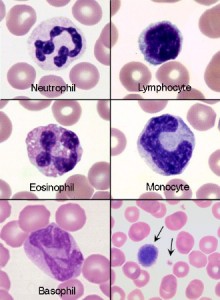Canine neutrophils are distinctly lobulated (less than 5 lobules) and have a colorless cytoplasm (secondary granules are not discernible). Low numbers of band neutrophils (1%) can be seen in the blood of healthy dogs. Neutrophils outnumber lymphocytes in health. Small lymphocytes dominate, but low numbers of intermediate lymphocytes, granular lymphocytes and lymphocytes with slightly increased amounts of pale cytoplasm, can be seen in healthy dog blood. Monocytes are similar to other species, but some dog monocytes mimic band neutrophils by having distinct horse-shoe shaped nuclei, as illustrated here. Monocytes in all species have pleomorphic nuclei, finer chromatin than neutrophils, more diffusely gray-blue cytoplasm and frequently contain low numbers of vacuoles (or rarely, red cytoplasmic granules). Eosinophils have round red granules and a light blue cytoplasm. Some species of dogs, such as Greyhounds, have vacuolated eosinophils (eosinophil granules lack myeloperoxidase and do not stain red). Their eosinophils can mimic monocytes but are far more vacuolated. Dog basophils have long, ribbon-like nuclei and faint purple granules. They can mimic a monocyte, but the cytoplasm has a different color and the nucleus is thinner. Canine red blood cells are biconcave discs with fairly deep central indentation and therefore, when spread on a slide have quite noticeable central pallor. Dog red blood cells are quite uniform in size and platelets are usually uniform in size, with some large platelets being seen (the arrows point to two platelets of markedly different sizes in blood from a healthy dog). Some dog breeds have inherited macrothrombocytes (e.g. Cavalier King Charles Spaniels, Cairn Terriers) and can be mildly to moderately thrombocytopenic. Approximately 1% of red blood cells are polychromatophilic, indicating that they are aggregate reticulocytes. In healthy dogs, there is very little tendency for rouleaux formation and red blood cells in the optimum area of the smear should not form stacks of more than 2-3 cells.

